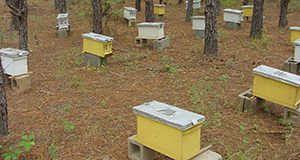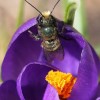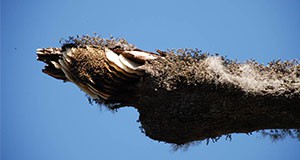
This 9-page illustrated fact sheet by James D. Ellis discusses the merits of using nucleus colonies, or nucs, which are smaller versions of full-sized Langstroth hives. The publication explains how to create and manage nucs and how to use them to control swarming, strengthen production colonies, re-queen hives, hive swarms, produce queens to sell to other beekeepers, and in general strengthen and expand a beekeeping operation. Published by the UF Department of Entomology and Nematology.
http://edis.ifas.ufl.edu/in869
Tag: Catherine M. Zettel Nalen
African Honey Bee: What You Need to Know
African honey bees entered the United States in the early 1990s and have since spread throughout the Southwest and Southeast, including parts of Florida. Compared to European bees, African bees are highly aggressive when disturbed and are more likely to sting humans and animals. This 6-page fact sheet covers the history and distribution of African honey bees in the Americas and explains how beekeepers and residents can manage their interactions with these bees. Written by H. Glenn Hall, Catherine Zettel-Nalen and James D. Ellis, and published by the UF Department of Entomology and Nematology, December 2014. http://edis.ifas.ufl.edu/mg113
Florida Master Beekeeper Program Requirements
 The Master Beekeeper Program (MBP) is a five-year (minimum) beekeeper training and certification program provided by the University of Florida. One must already be a beekeeper to enter the program. This 22-page fact sheet was written by James Ellis, Jerry Hayes, Catherine Zettel Nalen, William H. Kern, Ray Zerba, Brad Burbaugh, and Jeanette Klopchin, and published by the UF Department of Entomology and Nematology, October 2013.
The Master Beekeeper Program (MBP) is a five-year (minimum) beekeeper training and certification program provided by the University of Florida. One must already be a beekeeper to enter the program. This 22-page fact sheet was written by James Ellis, Jerry Hayes, Catherine Zettel Nalen, William H. Kern, Ray Zerba, Brad Burbaugh, and Jeanette Klopchin, and published by the UF Department of Entomology and Nematology, October 2013.
http://edis.ifas.ufl.edu/in847
Blue Orchard Bee, Osmia lignaria Say (Insecta: Hymenoptera: Megachilidae) (EENY549/IN982)
 The blue orchard bee, Osmia lignaria Say (Fig. 1), is a solitary mason bee native to the west coast of the United States and Canada. It is of great interest for use as a native pollinator of fruit trees and blueberries, and is easily managed due to its favorable biological characteristics. Blue orchard bees can be purchased online for pollination, and they are shipped as pupae ready to emerge in the spring. This 4-page fact sheet was written by Alden Estep, Catherine Zettel-Nalen, and James Ellis, and published by the UF Department of Entomology and Nematology, March 2013.
The blue orchard bee, Osmia lignaria Say (Fig. 1), is a solitary mason bee native to the west coast of the United States and Canada. It is of great interest for use as a native pollinator of fruit trees and blueberries, and is easily managed due to its favorable biological characteristics. Blue orchard bees can be purchased online for pollination, and they are shipped as pupae ready to emerge in the spring. This 4-page fact sheet was written by Alden Estep, Catherine Zettel-Nalen, and James Ellis, and published by the UF Department of Entomology and Nematology, March 2013.
http://edis.ifas.ufl.edu/in982
Preserving Woodenware in Beekeeping Operations (ENY125/AA244)
 The predominant material used to construct honey bee colonies in the U.S. is wood. Though honey bee hive components are simple in design, they are subjected to many extreme management techniques that cause wear and tear, ultimately shortening the life of the equipment. This article discusses how to protect colony woodenware, particularly the pieces that are exposed to the elements. These include the bottom board, hive body/supers, and lids. This 4-page fact sheet was written by J. D. Ellis, W. H. Kern, and C. M. Zettel Nalen, and published by the UF Department of Entomology and Nematology, June 2012.
The predominant material used to construct honey bee colonies in the U.S. is wood. Though honey bee hive components are simple in design, they are subjected to many extreme management techniques that cause wear and tear, ultimately shortening the life of the equipment. This article discusses how to protect colony woodenware, particularly the pieces that are exposed to the elements. These include the bottom board, hive body/supers, and lids. This 4-page fact sheet was written by J. D. Ellis, W. H. Kern, and C. M. Zettel Nalen, and published by the UF Department of Entomology and Nematology, June 2012.
http://edis.ifas.ufl.edu/aa244
Miner Bee, Chimney Bee Anthophora abrupta Say (EENY512/IN912)
 These gregarious, yet solitary, ground-nesting bees are “…conspicuous as they noisily swing their ponderous bodies to and fro on the wing, arrive home and scramble into their burrows or come tumbling out headlong and dash off into the sunny fields, with all the exuberance of boys just out of school.” This 5-page fact sheet was written by Jason R. Graham, Jamie Ellis, Glenn Hall, and Catherine Zettel Nalen, and published by the UF Department of Entomology and Nematology, December 2011.
These gregarious, yet solitary, ground-nesting bees are “…conspicuous as they noisily swing their ponderous bodies to and fro on the wing, arrive home and scramble into their burrows or come tumbling out headlong and dash off into the sunny fields, with all the exuberance of boys just out of school.” This 5-page fact sheet was written by Jason R. Graham, Jamie Ellis, Glenn Hall, and Catherine Zettel Nalen, and published by the UF Department of Entomology and Nematology, December 2011.
http://edis.ifas.ufl.edu/in912
Sweat Bees, Halictid Bees, Halictidae (Insecta: Hymenoptera: Halictidae) (EENY499/IN897)
 Sweat bees are very important pollinators for many wildflowers and crops, including stone fruits, pomme fruits, alfalfa and sunflower. Sweat bee populations can be encouraged with wildflower plantings and by providing nesting areas. Halictids typically nest in bare soil located in a sunny location. Minimum tillage and insecticide use will help to increase populations of Halictidae and other soil nesting bees. Learn more about this diverse family of bees in this 5-page fact sheet was written by Katie Buckley, Catherine Zettel Nalen, and Jamie Ellis, and published by the UF Department of Entomology and Nematology, August 2011.
Sweat bees are very important pollinators for many wildflowers and crops, including stone fruits, pomme fruits, alfalfa and sunflower. Sweat bee populations can be encouraged with wildflower plantings and by providing nesting areas. Halictids typically nest in bare soil located in a sunny location. Minimum tillage and insecticide use will help to increase populations of Halictidae and other soil nesting bees. Learn more about this diverse family of bees in this 5-page fact sheet was written by Katie Buckley, Catherine Zettel Nalen, and Jamie Ellis, and published by the UF Department of Entomology and Nematology, August 2011.
http://edis.ifas.ufl.edu/in897
ENY157/IN872 Theft, Vandalism, and Other Related Crime in the Beekeeping Industry: A Guide for Beekeepers
ENY157, a 2-page fact sheet by C.M. Zettel Nalen and J.D. Ellis, provides recommendations for crime prevention in beekeeping operations, what to do if hives or equipment are stolen or vandalized, and resources for beekeepers. Published by the UF Department of Entomology and Nematology, September 2010.
http://edis.ifas.ufl.edu/in872
ENY152/IN868 The Benefits of Pollen to Honey Bees
ENY152, a 4-page illustrated fact sheet by Amanda Ellis, Jamie Ellis, Michael O’Malley and Catherine Zettel Nalen, provides an overview of the nutritional needs of honey bees with an emphasis on the role of pollen — nutritional content, where it is produced, how it is collected, and how to ensure colony nutrition. Published by the UF Department of Entomology and Nematology, September 2010.
http://edis.ifas.ufl.edu/in868
EENY473/IN855 Varroa Mite, Varroa destructor Anderson and Trueman (Arachnida: Acari:Varroidae)
EENY473, an 8-page illustrated fact sheet by James D. Ellis and C. M. Zettel Nalen, is part of the Featured Creatures collection. It describes this devastating pest of Western honey bees — distribution, description, life cycle, economic importance, detection, and management. Includes references. Published by the UF Department of Entomology and Nematology, June 2010.
http://edis.ifas.ufl.edu/in855
ENY156/IN848 Florida Beekeeping Management Calendar
ENY156, a 7-page fact sheet by J.D. Ellis and C.M. Zettel Nalen, provides Florida beekeepers a reference for honey bee colony management with specific guidance for region by month, including recommendations for major management considerations and blooming plants. Includes reference. Published by the UF Department of Entomology and Nematology, May 2010.
http://edis.ifas.ufl.edu/in848
ENY155/IN847 Florida Master Beekeeper Program Requirements
ENY155, a 9-page fact sheet by James Ellis, Jerry Hayes, Catherine Zettel Nalen, William H. Kern, Ray Zerba, and Brad Burbaugh, describes the requirements for this beekeeper training and certification program provided by the University of Florida. Published by the UF Department of Entomology and Nematology, May 2010.
http://edis.ifas.ufl.edu/in847
EENY472/IN845 Bee louse, bee fly, braulid, Braula coeca Nitzsch (Insecta: Diptera: Braulidae)
EENY472, a 3-page illustrated fact sheet by James D. Ellis and C.M. Zettel Nalen, is part of the Featured Creatures collection. It describes this wingless fly that lives as a commensalist in western honeybee colonies — distribution, description, life cycle and behavior and management. Includes references. Published by the UF Department of Entomology and Nematology, April 2010.
http://edis.ifas.ufl.edu/in845
ENY147S/IN863 Diferencias Entre Abejas Melíferas Europeas y Africanas
ENY-147S, a 3-page illustrated fact sheet by M. K. O’Malley, J. D. Ellis, C. M. Zettel Nalen and Pablo Herrera, is the Spanish language version of ENY147/IN784 Differences between European and African Honey Bees. It describes key differences between these two sub-species of Apis mellifera in their hive defense and stinging, swarming and absconding, and selection of nesting site. Includes references. Published by the UF Department of Entomology and Nematology, August 2010.
http://edis.ifas.ufl.edu/in863
EENY434/IN792 Yellow fever mosquito Aedes aegypti (Linnaeus) (Insecta: Diptera: Culicidae)
EENY-434, an 8-page illustrated fact sheet by Catherine Zettel and Phillip Kaufman, is part of the Featured Creatures collection. It describes this container-inhabiting mosquito that is the primary vector of yellow fever — its synonymy, distribution, life cycle, medical importance, and management. Includes selected references. Published by the UF Department of Entomology and Nematology, February 2009.
http://edis.ifas.ufl.edu/IN792
